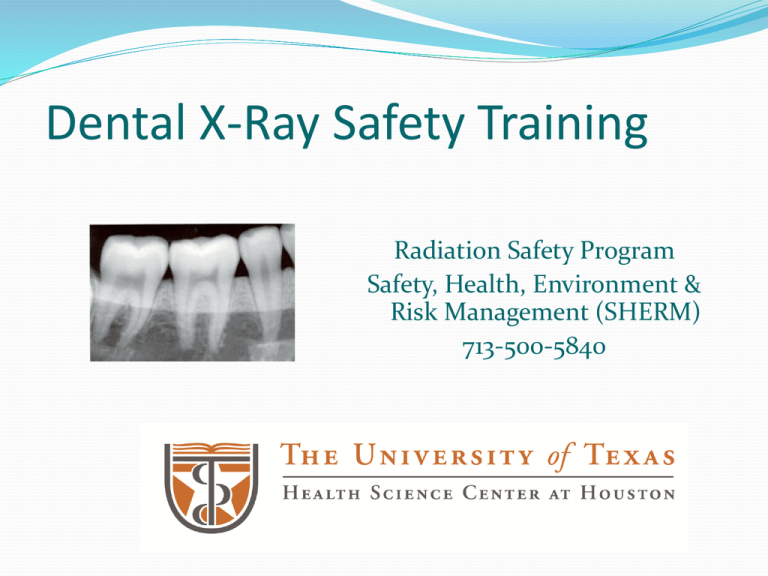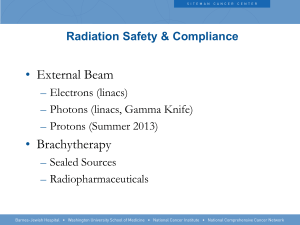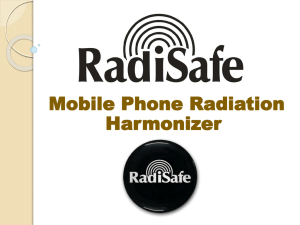Dental X-Ray Safety Training
advertisement

Dental X-Ray Safety Training
Radiation Safety Program
Safety, Health, Environment &
Risk Management (SHERM)
713-500-5840
THE SHERM MISSION
Safety, Health, Environment and Risk Management’s (SHERM)
mission is to work in conjunction with the UTHSC-H community to
ensure that education, research, and health care services activities
take place in conditions that are optimally safe and healthy for all
student, faculty, staff, visitors, surrounding community and the general
public.
Put simply, we exist to help people go home as healthy and safe as
they arrived.
Outline
Fundamentals of radiation
How x-rays are produced
Annual background exposure
How to minimize your radiation exposure
Instructions for the radiation monitoring program
Potential biological effects from radiation exposure
Operating and Safety Procedures
Access to applicable dental radiation regulations
Radiation Safety contact information
What is radiation?
Emission of energy in the form of
particles (e.g. beta) or waves (e.g. x-rays)
“Ionizing” radiation has enough energy
to remove an orbital electron and
produce ions.
Radiation Spectrum
Radio
Microwave
Infrared
Visible
Ultraviolet
X-ray
Gamma
Ray
103
10-2
10-5
.5 x 10-6
10-8
10-10
10-12
Wavelength (meters)
Electromagnetic radiation travels through space in the form of waves.
Waves of all types have an associated wavelength and frequency.
Radio waves have the longest while gamma rays have the shortest
wavelength.
Wilhelm Roentgen Discovers X-rays
November 8, 1895
While studying cathode ray
tubes, he noticed that the
fluorescence occurred in a
cathode ray tube even when
shielded from outside light
Discovery instantly
revolutionized physics and
medicine
X-Ray Tube
Tungsten Target
X-ray Tube Anatomy
X-rays are produced by energy conversion when a fast
moving stream of electrons is suddenly slowed down
in the target (e.g. tungsten) anode of the x-ray tube.
Natural and Manmade
“Background” Radiation
National Annual Average Exposure is 625 mrem
Other Man-made
Computed
sources
Tomography
3%
24%
Consumer
Products
2%
Cosmic
4%
Terrestrial
5%
Internal Emitters
6%
Medical
Radionuclides
13%
Interventional
Fluoroscopy
6%
Radon
37%
Diagnostic Imaging
5%
Note: Medical procedures are not occupational but exposures as a patient.
Radon
Largest contributor to background radiation in the U.S.
Noble gas
not readily incorporated into tissues
deposited to the lungs via nuclides attaching to aerosols
in the air
Seeps into basements and foundations of homes and
buildings
location, building materials, and soil determine radon
exposure
X-ray Output
The dose to the patient may change by varying the
parameters of the x-ray machine such as:
Total exposure time
Tube current (mAs) {Controls the # of x-rays}
Kilovolt peak (kVp)
Beam shaping
Collimation
Minimize Exposures by
Combining the use of
Least Time
Greatest distance
Appropriate shielding
In order to maintain doses
= As Low As Reasonably Achievable
ALARA Techniques
Minimize the time spent in unshielded
environments while the x-ray beam is on
Avoid anyone beyond the patient being
in the area while x-ray beam is on
Stand at least 6 feet away from the
dental x-ray machine
Standing 6ft away verses 1 ft away reduces
the exposure by 1/36
1
6
2
1
36
ALARA Techniques
•
X-rays are easily shielded by
a layer of dense material,
like lead.
•
Exam room walls may be
shielded to protect the
public areas.
•
Protective aprons, leaded
walls and leaded glass
barriers in diagnostic
radiology often block most
(~90% - 99%) of the
radiation.
Tissue Plexiglas
Thin
Lead
Thick
Lead
Protective Equipment
Personnel Protective
Apparel
Lead aprons, gloves,
thyroid shields
Visual and tactile examination
of leaded aprons is required
annually
Occupational
Exposure
Any worker who receives
radiation exposure while
performing a job or task.
The worker is required to wear
dosimetry if their job tasks produce
high enough exposures that they are
“likely” to exceed 10% of the
occupational dose limits.
Annual Radiation Exposure Limits
Occupationally Exposed Worker:
rem
5
15
50
0.5
0.5*
mrem
Whole body
5000
Eye
15,000
Shallow
50,000
Minor
500
Pregnant Worker
500*
*in 9 months
General Public: 100 mrem/year or 2 mrem/hour
Dental X-ray Regulations for Monitoring
Occupational Exposures
25 TAC §289.232(d)(6) – No individual monitoring shall
be required for personnel operating only dental
radiation machines for dental diagnostic purposes
UTHSC-H, EH&S will monitor dental x-ray operators
who request dosimetry.
Quarterly change out is typical at UTHSC-H for
personnel operating dental x-ray machines
How to Obtain
a Badge…
Fill out form (RS-03)
available online or by
contacting Radiation
Safety Program
http://www.uth.tmc.edu/safety/radsafety/rs03.htm
http://www.uth.tmc.edu/safety/radsafety
Proper Badge Locations
At the collar
&
outside any lead apron
Wear any specially
assigned abdomen
badge at the waist
under any protective
apron
Declared Pregnancy
When you contact RSP regarding your pregnancy, RSP will
schedule a confidential meeting to:
Review the risks associated with prenatal exposures and
methods to minimize risks
Review previous personnel monitoring results
Review exposure limits
Discuss the NRC Regulatory Guide 8.13
Provide an opportunity for questions
Provide additional monitoring if appropriate
Assist you in completing the written declaration
Declared Pregnancy
Program to assess, monitor, define and minimize
exposures to the developing fetus.
Limit is 500 mrem per gestation period
It is the individual’s decision to contact the Radiation
Safety Program (RSP) and provide a written declaration
of pregnancy for the lower limit to be applied.
With a recommendation of a 50 mrem limit per month
In rare cases, job duties or assignments may be reevaluated and changed.
http://www.nrc.gov/reading-rm/doc-collections/reg-guides/
occupational-health/active/8-13/index.html
Contact the RSP
at 713-500-5840 or
CYF G.102 to
discuss pregnancy
and radiation.
We will assist you in
completing the
shown (RS-14)
form.
http://www.uth.tmc.edu/safety/radsafety/
Pregnant%20Employee's%20Guide%20to%20Radiation.html
Potential Biological Effects?
Biological Damage
Radiation may…
Deposit Energy in Body
Cause DNA Damage
Create Ionizations in Body
Radiation is a weak carcinogen
(chronic effect)
Leading to Free Radicals
Which may Lead to Biological Damage
A dose of 1,000 mrem increases your
risk in cancer by ≈ 0.04%
Acute effects (e.g. erythema) have a
threshold and the dose increases the
severity of effect
Biological Effects
C ritic a l R a n g e s
D ose
A c u te E ffe c ts
1 0 0 – 1 0 0 0 re m
3 0 0 re m
T e m p o ra ry e p ila tion
o c cu rs
D a m a g e to b lo o d
c e lls
6 0 0 re m
F irs t d e g re e b u rn
1 0 0 0 – 3 0 0 0 re m
2 0 0 0 re m
S e c o n d d e g ree b urn
D a m a g e to s m a ll
in te s tin e
3 0 0 0 re m
S k in tiss u e d e a th
3 0 0 0 – 5 0 0 0 re m
5 0 0 0 re m
D e a th w ith in h o u rs
D a m a g e to
p a ra s ym p a th e tic
n e rvo u s s ys te m
Paperwork, paperwork . . . . . . . .
For the protection of patients & workers, there
are requirements
Federal regulations
State regulations
UTHSCH Standard
Operating Procedures
Equipment registration
Equipment
Calibrations
Hmmm…...
DSHS Requirements
Registration for all machines
If not digital x-ray unit
Log of developing chemical replacement
Darkroom tests (stray light)
Annual lead apron tests for integrity
Receipt/disposal records of equipment
Record of maintenance
Calibration of machines by Licensed Medical Physicist
Review of Standard Operating Procedures
Documented training
Patient log
Radiation Control, Texas
Department of State Health Services
Regulations are available at:
http://www.dshs.state.tx.us/radiation/rules.shtm
25 Texas Administrative Code (TAC)
§289.231 – X-ray Safety (General)
§289.203 – Notices to Workers
§289.232 – Dental Radiography
General Machine Requirements
Images must have dentist orders
Minimum distance is 6 feet from patient unless
standing behind protective barrier
Technique chart
Exclude unnecessary personnel from area
Keep out of direct beam path
Use shielding prudently (0.25 mm of lead)
Minimize retakes
Operators must be credentialed
Postings for Radiography Rooms
If you are pregnant or suspect
you are, please inform
the technologist
BEFORE
x-rays are taken.
Thank you.
Overexposure Data Background
Texas Department of State Health Services’ Radiation Control
(DSHS-RC) (formerly known as Texas Depart of Health’s
Bureau of Radiation Control (TDH-BRC)) is the designated
state agency for issues involving radiation in Texas
An essential function of the DSHS-RC is responding to
incidents and complaints
Records of such events have been recorded in text format
since 1956
This data is much more thorough than any other state or
federal government agency, but is not in a format that is
analyzable
Previous work performed by Dr. Robert Emery and Dr. Mike
Charlton examined, classified, and defined various events
that occurred from 1988-1997
Definition of Overexposure in Texas
Quarterly
Limit
Annual
General
Whole
Public Limit
Body Limit
>1.25 rem
per 3 month
period
>5 rem per >100 mrem
year
per year
Reported Radiation Incidents in Texas,
1956-2000 (n=6,102)
Unauthorized Disposal
Transportation Accident
2%
2%
Source Stolen
2%
Source Lost
8%
others
4%
Badge Overexposure
17%
Contamination
5%
Source Found
3%
Elevated Bioassay
2%
Equipment Damaged
2%
Improper Transport
1%
Source Fire
1%
Source Downhole
4%
Source Disconnect
1%
Irregularity
5%
Leaking Source
3%
Safety Violations
1%
Malfunction
2%
(n=6,102)
Overexposure
32%
Misadministration
4%
Overexposure Incidents in Texas by Total
Dose, 1956-2000
5-10 rem
25-100 rem 8%
>100 rem
2%
3%
10-25 rem
5%
Only 2% of the
overexposures in Texas
from 1956 to 2000 have
been high enough to
see acute clinical effects
<5 rem
82%
Initial Overexposure Conclusions
• Near equal prevalence of overexposures in
medical and industrial settings
• Significant decreases in overexposure
incidents
• Early 80’s, likely related to oil and gas exploration
activity in Texas
• After 1994, likely due to change in regulations
• Within the largest category of events in Texas
from 1956-2000, the occurrence of nonstochastic events was rare.
For Assistance or More Information…
Operating & Safety Procedures for Use of Radiation in
Dental Branch Clinics
Radiation Safety Website
http://www.uth.tmc.edu/safety/radiation_safety.html
For current version contact Ms. Adkisson’s office
Forms is the repository for standard forms (e.g., dosimetry,
training & experience)
Policies lists the basic radiation safety policies
Manuals – UTHSC-H Radiation Safety Manual
Radiation Safety Office Phone Number: 713 500 5840
In an Emergency (call): (713) 500 4357 (HELP)







